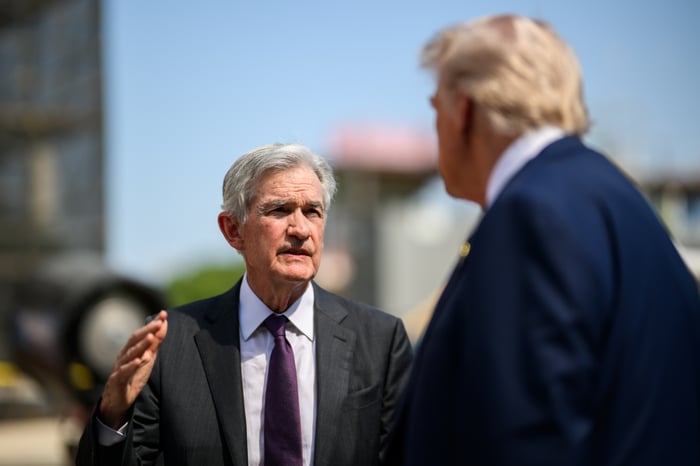For over 100 years, no other investment type has consistently matched the long-term annual returns of stocks. This year, we've seen the broad S&P 500 ( ^GSPC 0.01%), the enduring Dow Jones Industrial Average ( ^DJI 0.51%), and the innovation-driven Nasdaq Composite ( ^IXIC -0.28%) all reach a series of new record closing highs.
However, even though the stock market has shown remarkable resilience over decades, the journey from Point A to Point B is rarely smooth and uneventful.
As the S&P 500, Dow Jones, and Nasdaq Composite have climbed to unprecedented levels, stock valuations have followed suit. The surge in artificial intelligence (AI) has driven rapid expansion for some of Wall Street’s most prominent companies, and investors as a whole have largely chosen to overlook traditional valuation standards.

Fed Chair Jerome Powell speaking with President Trump. Image source: Official White House Photo by Daniel Torok.
Yet, Federal Reserve Chair Jerome Powell may have dampened the enthusiasm by openly addressing concerns about stock valuations.
Fed Chair Jerome Powell just highlighted the biggest historical risk to Wall Street
On September 23, Powell delivered remarks in Rhode Island and answered questions about the stock market and how the Fed’s Board of Governors considers equity valuations in its monetary policy decisions. Although the central bank’s leader usually refrains from commenting directly on the stock market, he offered a notably frank assessment:
We do look at overall financial conditions, and we ask ourselves whether our policies are affecting financial conditions in a way that is what we're trying to achieve. But you're right, by many measures, for example, equity prices are fairly highly valued.
The key takeaway is in these six words: "equity prices are fairly highly valued." When the Fed’s chief acknowledges how expensive stocks have become, ignoring the issue is no longer an option.
S&P 500 P/E 22.8x-the highest this century JPM
-- Mike Zaccardi, CFA, CMT 🍖 (@MikeZaccardi) October 2, 2025
30yr avg: 17.0x pic.twitter.com/U1T5XkZdZZ
It’s worth mentioning that Powell isn’t the only one warning Wall Street, investors, and the public about potentially overheated asset prices. Back in December 1996, then-Fed Chair Alan Greenspan gave a speech at the American Enterprise Institute, coining the now-famous term "irrational exuberance" to describe the rapid rise in asset prices during the early internet era.
Although Greenspan correctly identified that a revolutionary technology (the internet) was pushing market valuations higher, the S&P 500, Dow Jones Industrial Average, and Nasdaq Composite didn’t reach their dot-com era peaks until March 2000—over three years after his "irrational exuberance" speech.
Put another way, the global growth opportunities that AI presents are still an unknown factor, and may temporarily justify today’s elevated stock valuations.
Still, history has consistently shown that expensive stock markets eventually face corrections—and Jerome Powell is well aware of this pattern.
This is the second-priciest stock market over the last 154 years
To be fair, there’s no universal method for valuing individual stocks or the market as a whole. Differing opinions on what’s considered cheap or expensive are what make the stock market function.
However, one valuation metric stands out as nearly indisputable: the S&P 500’s Shiller price-to-earnings (P/E) Ratio, also known as the cyclically adjusted P/E Ratio or CAPE Ratio.
The Shiller P/E for the S&P 500 is calculated using the average inflation-adjusted earnings from the previous ten years. While the standard P/E ratio, which uses earnings from the past 12 months, can be skewed by economic downturns, the Shiller P/E’s decade-long perspective helps smooth out such disruptions. It’s the closest thing to a consistent valuation tool for comparing markets across more than a century.
S&P 500 Shiller CAPE Ratio data by YCharts .
Looking back to January 1871, the average Shiller P/E for the S&P 500 has been 17.29. Since the mid-1990s, however, this ratio has regularly exceeded its 154-year average, coinciding with the internet’s role in giving everyday investors greater access to information and confidence to invest in growth companies.
As of the close on October 1, the Shiller P/E stood at 40.04—just shy of its current bull market peak of 40.15. This marks the second-highest level for this ratio during a sustained bull market in the past 154 years.
The only period when stocks were collectively more expensive was just before the dot-com bubble burst. In December 1999, the Shiller P/E reached its all-time high of 44.19.
This valuation metric matters because the Shiller P/E has a remarkable track record for forecasting future market moves. While it doesn’t predict exact timing—stocks remained expensive for years before the dot-com crash—every previous instance where the ratio topped 30 was eventually followed by declines in the S&P 500, Dow Jones, and/or Nasdaq Composite ranging from 20% to as much as 89% (during the Great Depression).
With the Shiller P/E now at 40, it’s increasingly difficult to ignore these warning signs, no matter how optimistic the growth projections are for the largest companies.

Image source: Getty Images.
Time is the silver lining for investors
If history repeats itself in the near future, investors should brace for a drop of 20% or more in the major stock indexes.
Yet, the beauty of history is that it often swings both ways, and sometimes in investors’ favor.
The Shiller P/E has clearly demonstrated that Wall Street and investors eventually react to prolonged high valuations, resulting in significant corrections for the S&P 500, Dow Jones, and Nasdaq Composite. Still, history also shows that stock market cycles are far from linear.
In June 2023, the S&P 500 officially entered its current bull market by climbing more than 20% from its 2022 bear market low. At that time, Bespoke Investment Group shared a data set comparing the duration of every S&P 500 bull and bear market since the Great Depression began in September 1929—nearly 94 years ago.
It's official. A new bull market is confirmed.
-- Bespoke (@bespokeinvest) June 8, 2023
The S&P 500 is now up 20% from its 10/12/22 closing low. The prior bear market saw the index fall 25.4% over 282 days.
Read more at https://t.co/H4p1RcpfIn . pic.twitter.com/tnRz1wdonp
Bespoke’s research identified 27 separate occasions when the S&P 500 dropped at least 20% after a bull market, showing that bear markets are both common and unavoidable.
More significantly, the average bear market lasted only 286 days, or about nine and a half months. None of the 27 bear markets since the Great Depression have lasted longer than 630 days.
Conversely, the typical S&P 500 bull market has persisted for 1,011 days (roughly two years and nine months), and the current bull market marks the 14th time since September 1929 that a bull market has outlasted the longest bear market.
Time is ultimately on investors’ side. With enough patience, the major indexes tend to recover from short-term losses and, as history suggests, eventually reach new highs.